Shanghai - Korea
(Photos WS)
China with Shanghai and Port Arthur, Korea, Vladivostok, Hiroshima and Osaka - what an offer had been that voyage by Princess Cruises in spring 2011. It has become possible after China had abandoned cabotage restrictions and Russia had opened its strategic harbour Vladivostok to foreign passenger ships. But months before departure from Shanghai the bad news of the North Korean attacks made headlines, the U.S. Navy had to protect South Korea. Finally the information arrived: "Please be advised that due to the recent tensions between North and South Korea, the call to Inchon on March 25 has been cancelled." We'll not see this 'country of the morning calm', the country of dreams for decades. Not enough: Ten days before our departure from Germany, earthquake and Tsunami raged in Japan, the media published horror news about nuclear power stations there and in Germany panic was stirred up like after the Chernobyl disaster in 1986, good for the coal and oil promotion. But we've been in nearby Kiev three weeks after the Chernobyl disaster, we spent some wonderful days there and the night before departure there was given a party in the hotel and we danced Krakoviak or what it might have been. So, nothing could prevent us from flying to Shanghai for sailing to Japan...
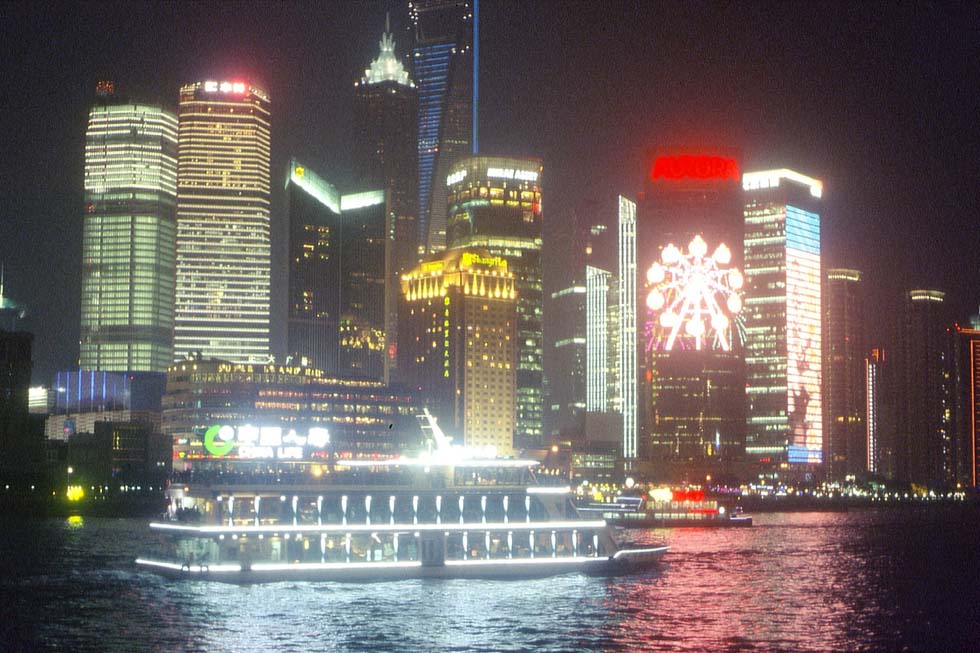
Shanghai
Be in Shanghai after a flight crossing the Gobi desert and after a maglev train ride from the airport at a speed of 430km/h before entering the city. Have reserved a room in a hotel on the Bund, once the heart of European capitalism, the boulevard framed by buildings of the colonial epoch and get ravished by the sight of the new Pudong skyscrapers, frantically illuminated, while on the Huangpu Jiang river in front dozens of night excursion boats are passing by... That's Shanghai, the metropolis which in the past "has attracted every kind of fortune-hunter, rebel, conspirator, gangster and smuggler", so described by the Princess Cruise guide, continuing: "It became the wildest city on earth, famed for its luxurious and flamboyant lifestyle where every form of vice flourished." Hollywood star Marlene Dietrich was quoted confessing: "More than one man was necessary in order to change my name into Shanghai Lily."
Nowadays' Shanghai is the city where the hustle and bustle of the 20-million metropolis is raging, the city where more motorcar and bus drivers than anywhere else are ignoring red traffic lights, making Piraeus or Cairo looking disciplined, the city where almost at every corner a street-vendor is selling a so-called "Rolex" watch at ten dollars or something else, all-in-all a city of friendly people. Someone on the Bund asks: "From where?" - "Germany, Munich" - whereupon he answers: "Bayern, Beckenbauer, Hoeness".
There are the places of quietness, too, the most renowned for foreign visitors being the Jade Buddha Temple. Though crowds of people are flocking there, many ones are kneeing, praying and the yellow-dressed monks seem to resemble another world. The thought is coming that Jesus and Buddha have made shake-hands in eternity...
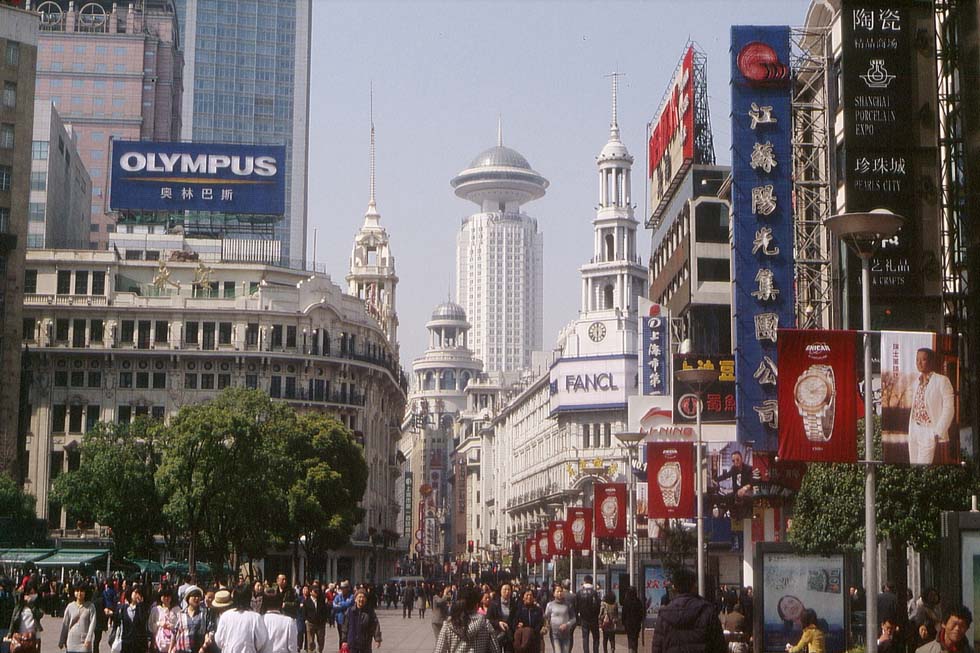
Shanghai, Nanjing Road
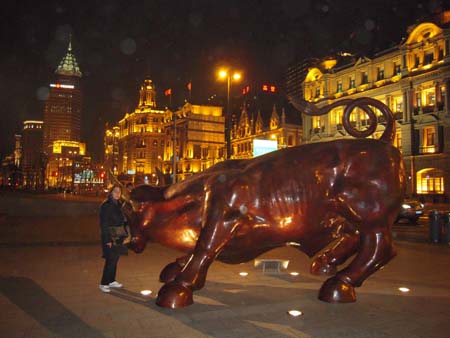
Shanghai, the Bund
|
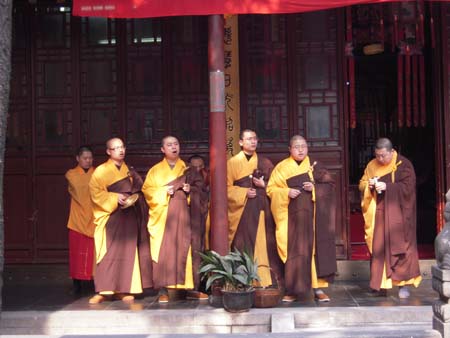
Jade Buddha Temple
|
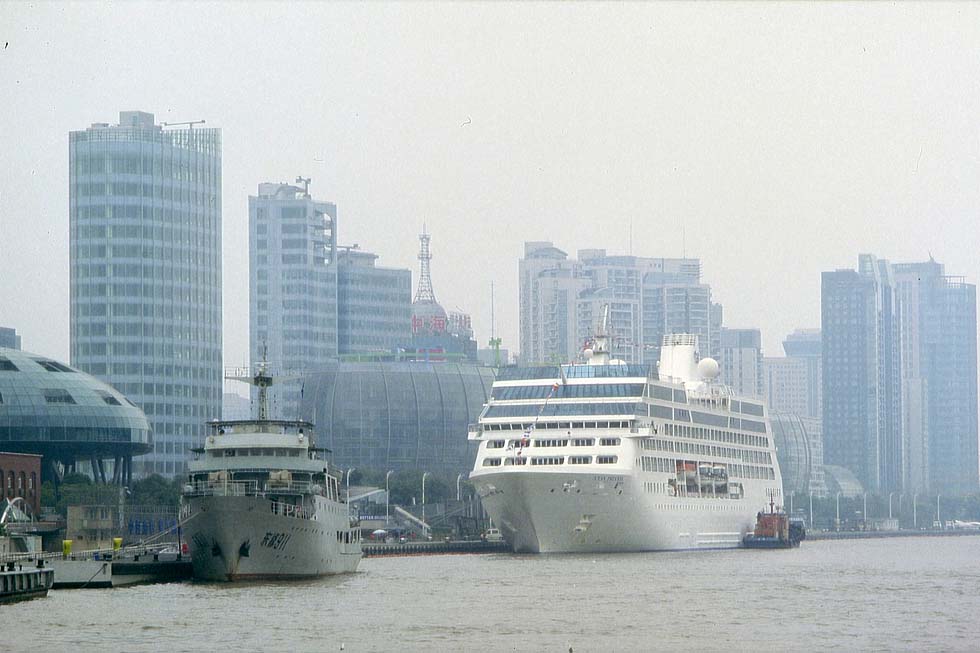
"Ocean Princess", Shanghai 2011
From the Bund, a white cruise ship can be watched being moored close to the International Passenger Ferry Terminal on the Huangpu Jiang river. It proves being the "Nautica" of Oceania Cruises, one of the R-class vessels, once built for Renaissance Cruises, having gone bankrupt. These ships are midsize with a moderate gross tonnage of 30,277 and a low deadweight and so they can enter the river, while the massive ocean liners, beginning with the "Empress of Canada", had to anchor outside Shanghai at Woosong (now Wusong) on the Chiang Jian, known as the Yangtse river, connected by rail. Days after, "our" R-class ship is berthing at the International Cruise Terminal - the "Ocean Princess" of Princess Cruises. But what rumours can be heard in the hotel, the route has been changed, going to Hong Kong instead of Japan? Two passengers from America and Korea, later our friends Mark and Ki Bong, are confirming the route change to Hong Kong via Korea and Taiwan instead of Osaka via Vladivostok. Despite the earthquake catastrophe in Japan, the port of Osaka with the Tempozan Wharf has not been closed, but probably anxiety among the passengers had caused the change. What shall we do with our flight home, booked from Tokyo? Phone calls and e-mails with help of the friendly staff of the Hyatt hotel have no result, uncertainty remains. May we get stranded in Hong Kong?
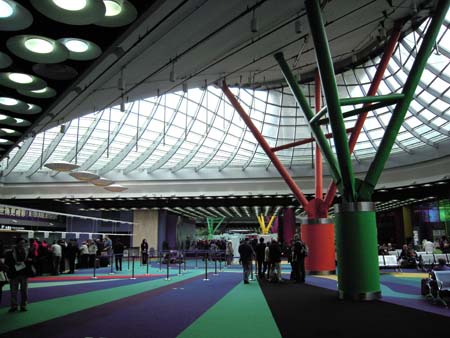
Shanghai terminal
|
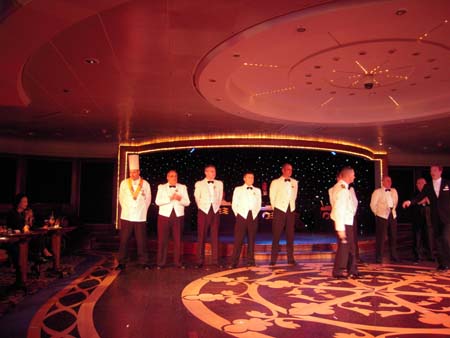
"Ocean Princess"
|
On Sunday, 20 March 2011, the check-in takes place in the terminal. Boarding the ship, the "Ocean Princess" welcomes us with her decent elegance, old-style, but not exaggerated. In 1999 she had been delivered by Chantiers de l'Atlantique to Renaissance Cruises as "R Three", taken over in 2002 by Princess Cruises, initially as "Tahitian Princess" for South Pacific itineraries. The maximal number of passengers is 777, sympathetically moderate. Departure time is Monday in the evening. Past the ferry "Su Zhou Hao", moored on the quay and bound for Japan, the ship goes downstream the Huangpu and the illuminated skyline of Pudong is left behind. The onboard information is giving details: "Once in proximity of Wusong lighthouse, we alter to our starboard side, disembarking the first river pilot, proceeding through the busy Chang Jiang River towards the open sea...".
Once clear of the Shanghai channel in the early morning, the ship is following a northerly course towards the Yellow Sea. With the friendly help of Justyna Fron, the internet lady on board, a number of e-mails is sent in order to change the return flight to Hong Kong and finally in the afternoon the good news arrive, Lufthansa has changed the booking. We feel like Saint-Exupery when he has been saved after having stranded in the Sahara... It's right in time before the Captain's Cocktail Party begins and we can confirm to Captain Stefano Ravera that the route change caused no longer any problem - and he, an Italian, speaks fluently "Schwyzerdeutsch", he had learned it in Switzerland. In the evening the formal dinner takes place. Most guests are Americans, some wearing the white dinner jacket and we, together with our tablemates from Mainz, are the only German passengers, then joined by a couple from America and soon we all are friends. The cuisine is of a high standard - no wonder, the Executive Chef Antonio Costandino comes from Italy. Then a show is presented in the Cabaret Lounge, Rock'n Roll and the "Beatles", the boys could have been the grandsons of the passengers.
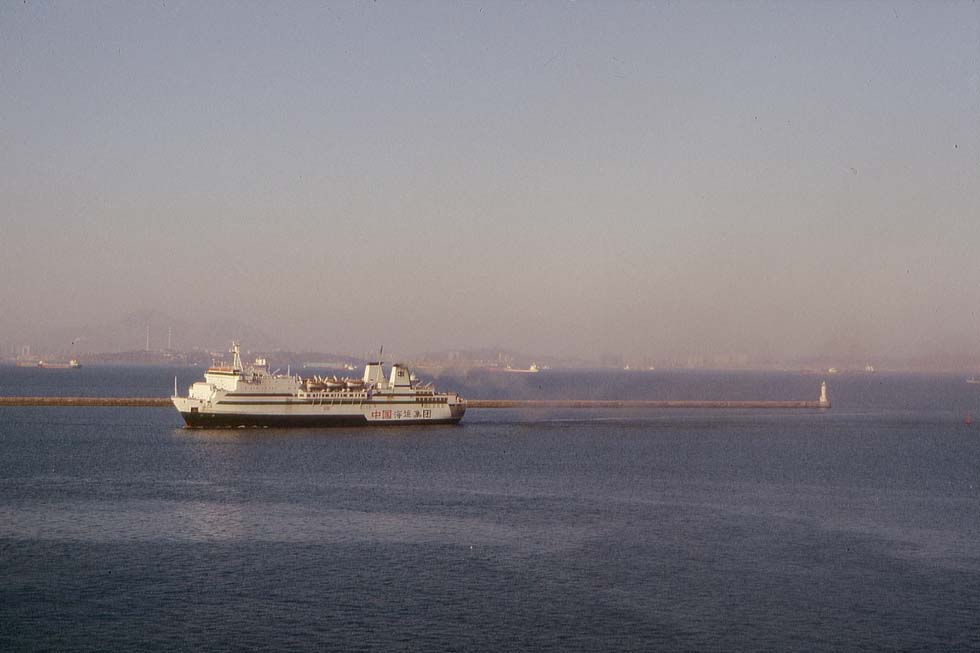
"Chiang Chin Dao" arriving at Dalian, 2011
Next morning the ship is to arrive at Dalian on the southern tip of the Liaodong peninsula - "a desired treasure for many nations", as the Princess Cruises' folder informs, continuing: "Dalian was first brought to international attention as a result of Japan's victory in the Sino-Japanese War of 1894-95... Recognizing that Japanese occupation would confound peace efforts in the Far East, six days after the treaty's signature, Imperial Russia, supported by France and Germany, forced the Japanese to relinquish possession of the peninsula". Russia got "the rights to construct a railway from Harbin in central Manchuria to Dalian, thus connecting the port by rail to the Trans Siberian railroad and European Russia... In 1904, Imperial Japan, remembering its earlier humiliation at the hands of Czarist Russia, struck back... Japanese torpedo boats attacked and destroyed Russia's Pacific Fleet at anchor in Dalian's military base, Port Arthur... The development of Dalian as a port and railway terminus continued under Japanese control. The port served as a jump-off point for Japan's invasion of Manchuria in 1931. At the conclusion of World War II, Russian troops again occupied Dalian under terms agreed upon at the Yalta Conference of 1945. The last Russian soldiers left in 1955."
After having passed Dasanshan Dao island, the ship enters the harbour of Dalian at 9 o'clock in the morning. It is described as one of China's busiest harbours and indeed a number of ferries have already berthed there, the "Xin Sheng Sheng", the "Da-In", the "Pu Duo Dao" and the "Wan Dong Hai" of different enterprises, most ones for crossing the Bo Hai Strait on the way to central China. The city with its 6 million inhabitants is topped by modern skyscrapers, but after a walk to the Zhongshan square, some monumental buildings in Stalin-style can be seen as a reminder of the Soviet time, when this had been the "Stalin Square". Pass on, and you'll arrive in the "Russian" road, where the old houses with pointed roofs and some dealers' signs in Russian make you feel like having arrived in the Czar's empire. What a dream must have been a Trans-Siberian Express arriving there from Moscow... In the nearby new Dalian railway station a light-grey/blue express has arrived, it may have come from Shenyang, but the romance of the past revives with an old regional train in green colours, the paint scheme of the traditional Siberian and Chinese expresses decades ago.
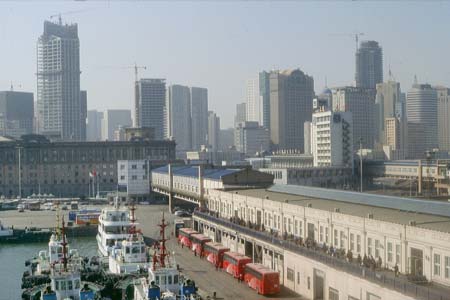
Dalian Pier
|
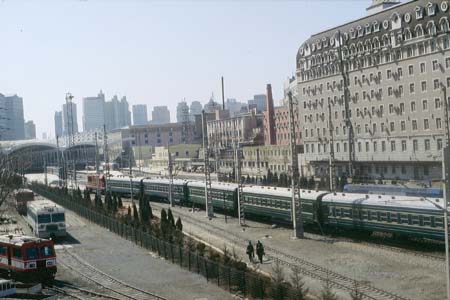
Dalian railway station
|
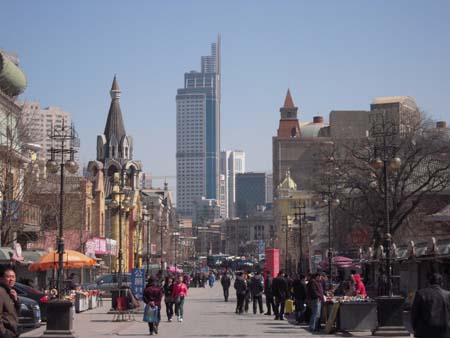
Dalian, the "Russian" road
|
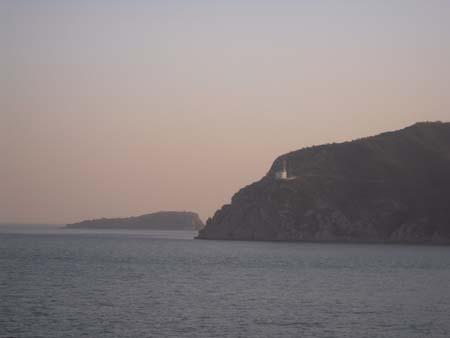
Lighthouse near Lushun
|
Back to the ship, from the upper deck a hi-speed boat can be watched and two ferries of China Shipping Passenger, entering the harbour. Then the tremendous sound of the "Ocean Princess" is signaling the departure. The ship clears the harbour and settles on a southerly course. Somewhere behind the rocky mountain range must be Lushun, the former Port Arthur. Once abeam of Yu Yan rock, the "Ocean Princess" alters to starboard onto a westerly course towards Tianjin.
The sun sets golden into the Yellow Sea. The dinner is informal and our German friends are telling stories from their cruises. Greenland has been their most fantastic experience, an inaugural trip of the "Norwegian Pearl" had been spoiled by vulgar youngsters, AIDA has a good cuisine, but always you've rock and pop in the ears. They had passed the Horn of Africa aboard a Costa ship, with a call at Aden in turmoil, and they had enjoyed the carnival of Rio. - "But we had experienced the carnival of Oruro, Bolivia, in 4,000 metres altitude", we answered. - "We, too", they replied... Then there is a magic show in the Cabaret Lounge, presented by Sean Alexander and Vanessa from England: Suddenly Vanessa has no head, decapitated, and then she has her head again...
Early morning call - and the "Ocean Princess" has already moored on the quay aside the large, modern terminal for our visit to Tianjin. This city with nowadays 11 million inhabitants had already in the 13th century under Kublai Khan been the seaport for the capital Beijing. In 1856 the British and French have shelled the fortifications and then they changed it from a sleepy provincial town into a centre of commerce with a Rue de France, a Via Vittorio Emanuele and luxury life for the rich, later disturbed however by earthquakes. Still in the 21st century, Tianjin remained as a stop for the Russian express Moscow - Beijing. And new Siemens high-speed trains started in 2009, covering the 118km to Beijing South within half an hour. Building a new harbour, 50km downstream at Tanggu, had been initiated by the Japanese in the 30s, completed in 1952. A container terminal was erected in 1976 and then the port region was renamed Xingang, what means "new port".
Our sightseeing bus is leaving the passenger terminal for the 60km-tour through the flat country to Tianjin, passing the container terminal, where not only COSCO, but also Hamburg-Sued and other famous labels can bee seen. A new city quarter is situated far away in the background. The busy motorway surrounds the modern outskirts of Tianjin and after almost two hours a stop allows to visit a traditional building, once the opulent mansion of a ship-owner's family, one of the richest in China, now a museum. The contrast could not be sharper when the bus stops at nowadays' modern museum, an extremely futuristic building consisting of a concrete and steel structure with a suspended glass roof. Half a century ago the author, after having completed the study in architecture, had presented a similar idea to an architects' competition, unnoticed of course. Now this futuristic building is refuting those European critics who still think that Chinese architecture is 'Maoist'. And futurism continues with the skyscrapers overtopping the venerable catholic church on the shore of the "Mother River". What a different China is it now, compared to the past, when the few foreign sailors arriving had to sing Mao songs and had to join a Maoist parade, as an experienced Captain has reported it. In the afternoon the bus is carrying the sightseers back to the ship.
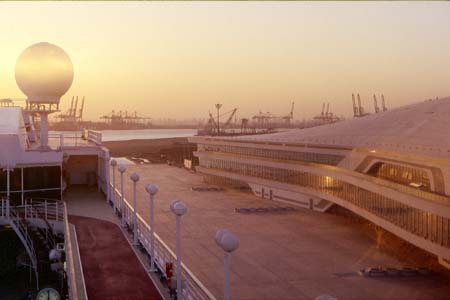
Terminal at Xingang, 2011
|
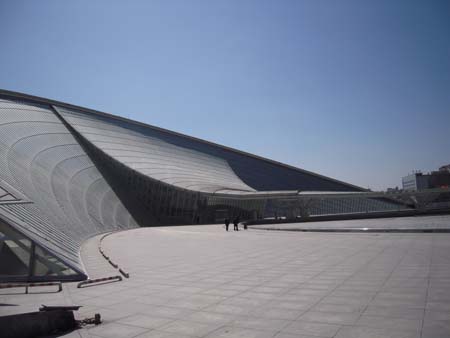
Tianjin
|
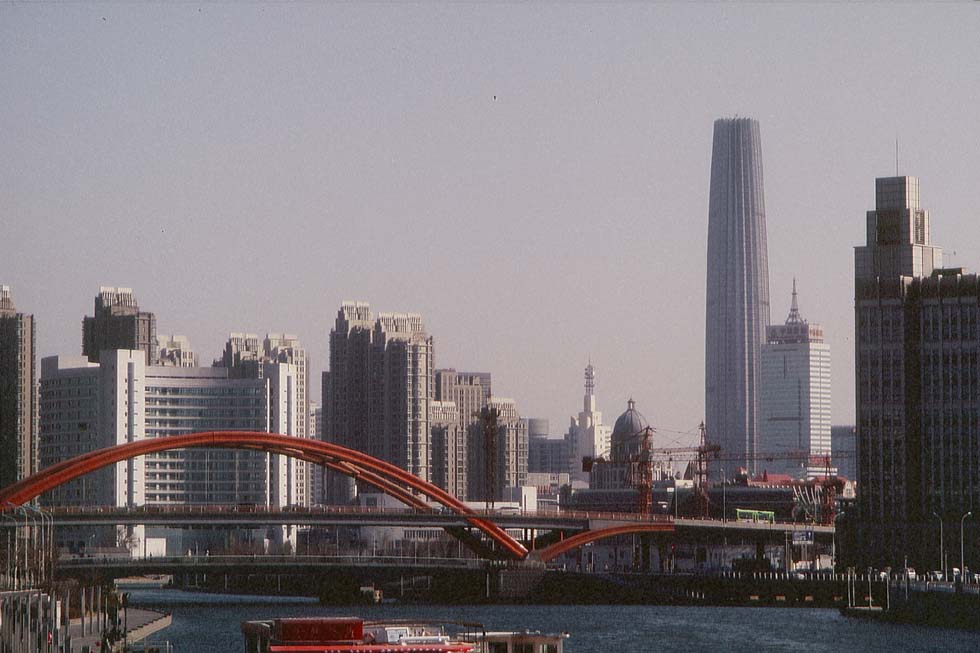
Tianjin
At 7 o'clock in the evening the "Ocean Princess" drops her mooring lines and begins to thrust off her berth. She sets various courses through the Tianjin Gang Main Channel and then to an east south easterly course through the Yellow Sea. After dinner the evening continues with a show and once again it is fantastic. "Another Jazz", they're singing and dancing in a jazzy madness, it's the craziness of the twenties...
Next day is a day at open sea. The weather is sunny, the Yellow Sea calm and blue. Sand and silt from the Yellow River and from the Hai He were not brought so far and no sand storm from the Gobi desert has raged. In the afternoon Barry Minkin, our tablemate, book author, consultant and futurist, is giving a lesson on globalization. The lessons are transmitted also on the TV screen and on another occasion he is speaking about global warming and the possibility of a climate catastrophe. He compares it with the die-out of the dinosaurs. The dinner on this evening is opulent, dedicated to the Thai cuisine.
Saturday, 26 of March: "Early this morning we passed Banseo light beacon on our starboard side at a distance of 1.7 nautical miles. Once clear of the beacon we altered to the north passing between numerous South Korean islands, proceeding to Palmi do pilot station where the pilot boarded the vessel before passing underneath Inchon Grand bridge towards the entrance of the lock. Once clear of the lock we set final courses towards our designated berth." That's the onboard information about the arrival at Korea's second-important harbour, now spelled Incheon. The port had been opened in 1883 to foreign trade, but in 1910 Korea was completely annexed by Japan, a situation lasting until the end of WWII. One of the most decisive campaigns in later history is described by the Princess Cruises Port Guide: "During the Korean War, the seaward approaches were only lightly defended by the North Korean invasion force, since they assumed that no major assault could succeed here. So it was a great surprise to them when General Douglas MacArthur planned and launched a successful landing by American and South Korean Marines in 1950." Nowadays' Incheon has 2.5 million inhabitants. Due to its proximity to the capital Seoul, connected by the suburban railway, the city is developing into a commercial hub.
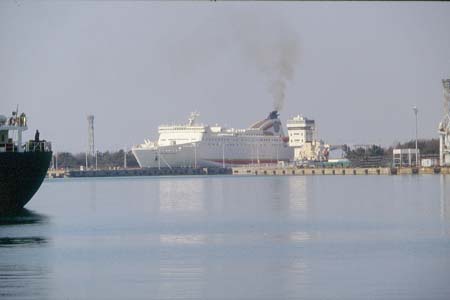
The "New Golden Bridge V", Incheon locks, 2011
|
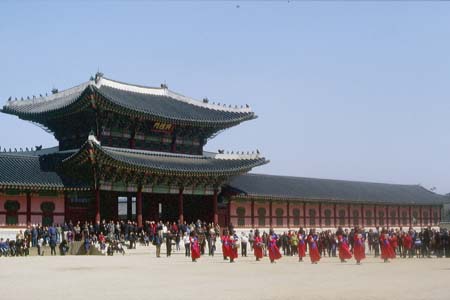
Seoul
|
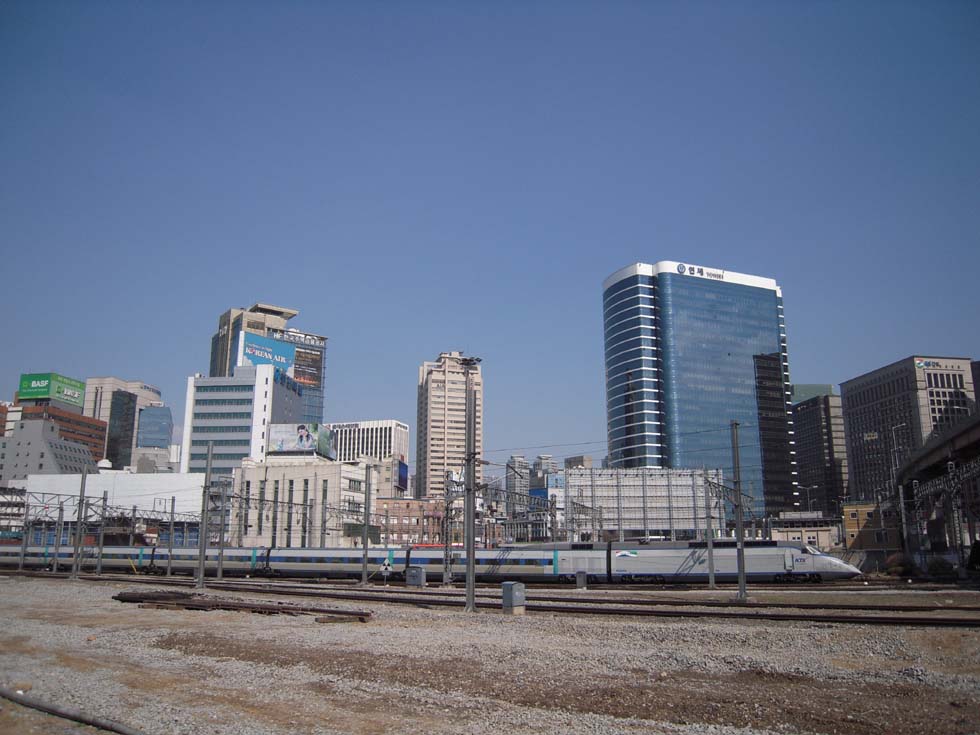
KTX high-speed train, Seoul 2011
The "Ocean Princess" is moored on the pier, the 30,000-ton "New Golden Bridge II" of Weidong Ferry and one of the rare conventional passenger-cargo ships of Lyg C-K Ferry in the background. Weidong containers are stapled in the port area and Weidong Ferry is the company which has pioneered the Korea - China route. The modern car-ferry "New Golden Bridge V" has cleared the lock and is entering the harbour. The locks have been erected on account of the tides on this coast. A new passenger terminal has been built in the north, but from our berth the suburban railway station can be reached easier, even on foot. Within a little more than an hour, we arrive in Seoul close to the vast area of the Gyeonbok Palace, the symbol of Korean tradition and pride since the Joseon Dynasty had started there to build up their empire, culture and Confucian teaching seven hundred years ago. And - by chance or by a miracle - our arrival is just in time to admire the spectacular parade in historic uniforms, shown by so many tourist books. It's a heavenly present, a present of Eternality... The walk leads us further to the Congye-Sa Temple, where we can join an immense crowd, praying silently. Later, in the Seoul railway station, the French-type high-speed trains to and from the southerly seaport Busan can be watched, but that's another story, good for our trains-worldexpresses Web site.
Back on board, it's already dinner time and then, in the Cabaret Lounge, a piano solo is given by Chris, who had played already aboard the "Norway", once the legendary "France". He is playing Gershwin, so furiously that he drowns even the thrusters when the ship manoeuvres off the berth and sets course towards the entrance of the lock. Once clear, the "Ocean Princess" is heading towards the Yellow Sea during a dark night...
|